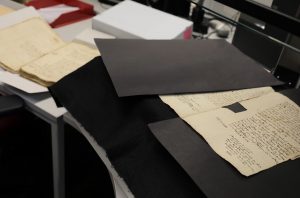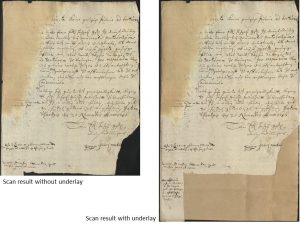Use case Spruchakten
The surfaces of file-sheets from the early modern times are usually uneven. Therefore, we always use a scanning glass-plate. Thus, at least rough foldings and creases can be smoothed and the writing can be straightened a little.
Contrary to the usual scanning procedure of books, we scan each page of a file individually. Thus, we deliberately excluded the possibilities of a subsequent layout processing of scans. Earlier digitization projects have shown that such post-scan layout editing can be laborious, error-prone and easily disrupt the workflow. But because subsequent layout processing was ruled out, the scans have to be produced as presentable as possible right from the start.
This is why we use the so-called “Crop Mode” (UCC project settings) for scanning. This automatically captures the sheet edge of the original and sets it as the frame of the scanned image. The result is an image with barely a black border. A possible misalignment of the sheet can automatically be compensated up to 40°. This leads to images that are reliably aligned and it also makes it easier to change pages during scanning.
For the “Crop Mode” to recognize a page and to scan it as such, only this page must be visible. This means that everything else, both the opposite side and the pages beneath, must be covered in black. For this purpose we use two common black photo cardboard sheets (A3 or A2).
In the Spruchakten there are often paper-sheets in which the lock-seals have been removed by cutting out. These pages must be additionally underlaid with a sheet as close as possible to the original colour. The “Crop Mode” will then complete the border so that no parts of the sheet are cut off during the scan.
Thus, during the scanning of the Spruchakten, we cannot simply “browse” and trigger scans, basically we have to prepare every single image. The average scanning speed with this procedure is 100 pages per hour. This way, we also save a possible costly post-processing of the images.


